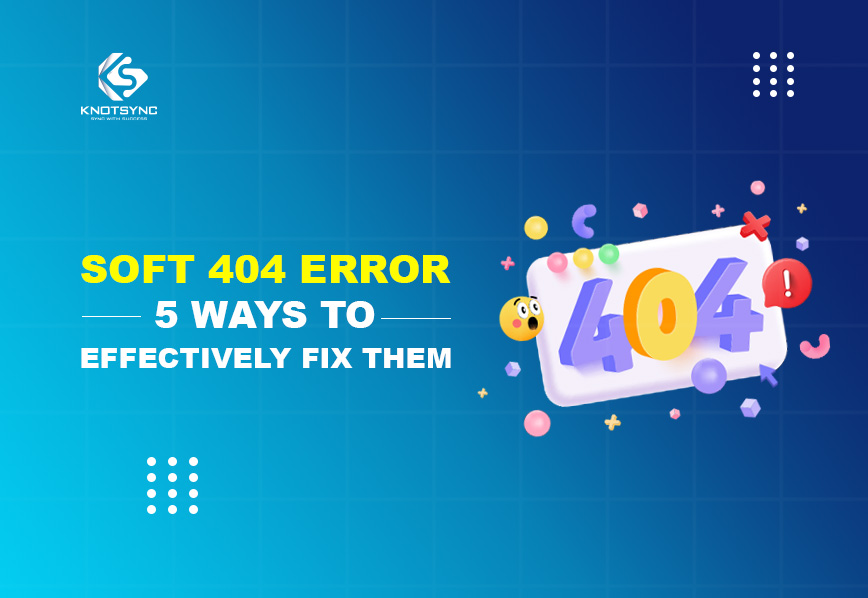If you’ve surfed the internet for any length of time, you’ve probably come across a 404-error page at some point. So, you get a “page not found“ message instead of the website you expected to enter.
As a web page loads, it always contains a response code in the HTTP headers. This is what a 404 error is. It is a code that displays “Not Found” as a result of page loading. On the other hand, a Soft 404 error is a whole different thing, and it can affect your search engine ranking.
If you see a Soft 404 error in the index status report of Google Search Console, it means that Google has crawled your website and discovered that the page doesn’t exist. There are several possible causes for this, but the most common one is that the page has been moved or erased. So, how to fix soft 404 errors so it doesn’t harm your website’s ranking and performance? Let’s discuss.
What Is Soft 404 Error and What Causes It?
A soft 404 error occurs when a page on a website is mistakenly identified as a 404 (Page Not Found) error, even though the page still exists. Instead of returning the correct HTTP error code (404 or 410 not found), the server incorrectly returns an HTTP status code 200 OK (success).
Simply put, when the page is invalid, your server delivers a 200 OK code to search engines indicating that the page is valid rather than providing them with the appropriate error code so that they ignore it. One tool to identify such issues is Google Search Console, which helps to detect Soft 404 errors.
With the Soft 404 error, there is not just one cause; there could be several. So, this can lead to some technical detective work when you’re trying to fix them. Some of the most notable causes of these errors are:
Pages with minimal or little content: If a page has minimal content, search engines may assume it should return a 404 or 410 status code instead of a 200 OK code. For example, empty tag pages that display no content can trigger soft 404 errors
Misspellings in URLs: Typos or misspellings in URLs can lead to soft 404 errors. When visitors encounter these errors, they are notified, but search engine crawlers may still index and crawl the pages, causing soft 404 errors to persist.
Outdated or broken links: Using outdated links or broken internal and external links can contribute to soft 404 errors. Regularly auditing and updating these links can help prevent soft 404 errors from occurring.
Server-related issues: Problems with the server’s configuration or handling requests can also result in soft 404 errors. Incorrect server settings may cause valid pages to be incorrectly identified as “not found.”
Redirect loops or incorrect redirects: Improperly implemented redirects, especially redirect loops, can trigger soft 404 errors. These errors occur when a chain of redirections ends up pointing back to the original page, confusing both users and search engines.
By addressing these causes, website owners can effectively mitigate soft 404 errors and improve website speed, SEO of their website, and overall user experience. Here are more different ways to speed up your website.
Soft 404 Error vs. 404 Error: What is the Difference?
The difference between Soft 404 error vs. 404 error is significant because search engines evaluate soft 404 errors differently from regular 404 errors. Soft 404 errors can negatively impact a website’s SEO performance, as search engines may perceive them as low-quality content or poor user experience.
Therefore, it’s essential to address soft 404 errors to ensure that search engines correctly identify and handle pages that do not exist. Soft 404 error is quite confusing, so let’s break it down!
Soft 404 Error: A Soft 404 error occurs when a page is requested, and the server returns a 200 OK status, but Google thinks that the page should return a 404, known as a soft 404 error. This could happen if there is no content on the website or if the content appears incorrectly.
404 Error (Page Not Found): When a page returns a 404 error code, it means that the requested page was not found on the server. In this case, the server sends a clear message to users and search engines that the page does not exist. This is the expected and correct response for pages that genuinely do not exist.
In other words, a 404 error indicates a page genuinely does not exist, while a soft 404 error occurs when a page still exists but is incorrectly identified as not found.
5 Ways to Fix Soft 404 Error in Your Website
There is no straightforward answer to the question what is the best way to handle a 404 error. Several things depend on the page and what you want the page to do. However, the very least you can do when you have them is make sure that the page with the error always sends the correct error code.
Here are 5 ways you can fix soft 404 error to increase your website’s visibility and search performance:
1. Check for Proper HTTP Status Code
One of the main reasons for soft 404 errors is improper HTTP status codes. Ensure that your server is returning the correct status code for each page. The correct code for a valid page is 200 (OK). A page should return a 404-status code if it does not exist. This tells search engines the page is not found and prevents it from being wrongly flagged as a soft 404 error.
2. Improve Content
Once you’ve identified the problem pages, it’s time to improve their content. Dive into each page and assess the content’s quality, relevance, and depth. Ensure the information provided is valuable, accurate, and current. Enhance the content by incorporating relevant keywords, adding informative headings, and including descriptive titles. By improving the content, you can reduce the chances of soft 404 errors occurring.
3. Setup Correct 404 and 410 Error
To provide accurate information to search engines and users, setting up correct error codes for pages that don’t exist is crucial. Use the “404 Not Found” status code for temporary page absences. If a page has been permanently removed, utilize the “410 Gone” status code. This helps search engines understand the page’s status and prevents confusion or misinterpretation.
4. Use 301 Redirect
When a page has permanently moved to a new URL, implementing a 301 redirect can effectively guide users and search engines to the new location. A 301 redirect informs search engines that the original page has moved permanently, and any links or rankings associated with the old URL should be transferred to the new one. This not only helps in resolving soft 404 errors but also ensures a seamless browsing experience for your users.
5. Customize Error Pages
Custom error pages provide an excellent opportunity to engage with users and offer alternative paths when encountering non-existent or incorrect URLs. Create a captivating and informative 404 error page that suggests relevant content or provides a search box to help users find what they want. Customize the error page to match the aesthetics and branding of your website, ensuring a consistent and positive user experience even when errors occur.
What Is the Solution for the HTTP 404 Error?
An HTTP 404 error indicates that a requested webpage is not on the server. Effectively resolving this requires a few key steps:
Check the URL: Ensure the web page’s URL is typed correctly. Typos are common causes of 404 errors.
Redirect the Page: If the page has been moved or deleted, use a 301 redirect to guide users to the new location or a relevant page.
Update links: Modify or remove any internal links leading to the 404 page. Regular audits help keep your website’s navigation error-free.
Custom 404 Page: Design a user-friendly 404 page with helpful links and a search bar, making it easier for visitors to find what they need.
Contact Hosting Provider: If the error persists without a clear reason, contact your web hosting provider for assistance.
Following these solutions can help you effectively address HTTP 404 errors and ensure a smoother browsing experience for you and your website visitors.
This will help to quality drive traffic to your website. Here are more ways to drive traffic to your website.
Key Learnings
Dealing with 404 errors, especially the Soft 404 errors, is an advanced part of SEO, as not everyone can understand HTTP status codes and their meaning. So, we have simplified things for you. You can use Google Search Console to find and fix Soft 404 errors.
For the best SEO performance, you can contact our digital marketing expert, who will try to find and fix those errors for you to improve your website speed and performance.




